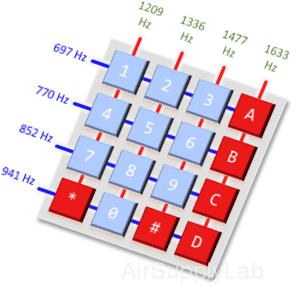DTMF (Dual-Tone Multi-Frequency)
The short term of the Dual-Tone Multi-Frequency is DTMF. DTMF Technology is used in push-button telephones, where when a key or button is pressed on the phone, a corresponding and unique tone will be generated. This tone is a combination of two different frequencies.
The DTMF system uses a set of eight audio frequencies transmitted in pairs to represent 16 signals, represented by the ten digits (0 ~ 9), the letters A to D, and the symbols # and *. The DTMF telephone keypad is laid out in a 4x4 matrix of push buttons and each button is associated with two frequencies as shown below. Each row represents the low-frequency tones (697, 770, 852, and 941 Hz) and each column represents the high-frequency tones (1209, 1335, 1477, and 1633 Hz) of the DTMF signal. Pressing a key sends a combination of the row and column frequencies. For example, the key 0 produces a superimposition of tones of 941 and 1336 Hz.

Figure 1: DTMF Keypad Layout and The Corresponding Tone Frequencies
The frequencies and the keypad layout of DTMF tone dialing have been internationally standardized, but the tolerances on individual frequencies may vary in different countries. The North American standard is 1.5% for the generator and 2% for the receiver. Moreover, the tone has to be held for a specific minimum time before it is accepted as a valid dialing digit. In North America, the minimum time for a digit is about 50 ms and the inter-digit interval is also about 50 ms.
The *, #, A, B, C, and D keys are widely used worldwide by amateur radio operators and commercial two-way radio systems for equipment control, repeater control, remote-based operations, and some telephone communications systems.